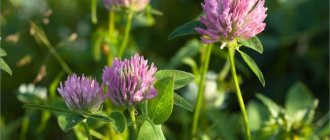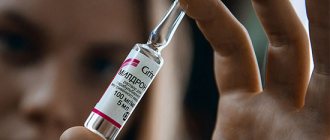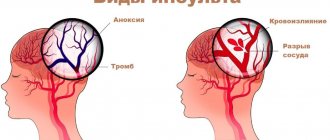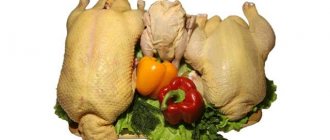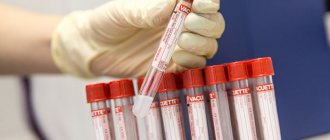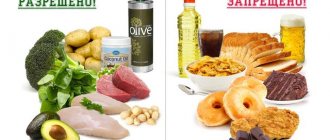Clover is a unique plant that has received recognition in folk and evidence-based medicine and is widespread in central Russia, Ukraine and Belarus.
Due to the content of vitamins, macro- and microelements, red meadow clover has a beneficial effect on the respiratory, cardiovascular, immune, circulatory and other systems of the body.
The most common deviation in which the consumption of flowers and leaves of this plant is indicated is an increased level of total cholesterol in the blood.
In one study, the isoflavones found in red clover actually demonstrated the ability to reduce “bad” LDL cholesterol by an average of 9.5%.
Is it true that the plant lowers cholesterol?
At the turn of the 20th and 21st centuries, a large randomized study was conducted that proved that when taking clover for 12 months, there was a decrease in total cholesterol and triacylglycerides compared to the control group.
An increase in “useful” high-density lipoproteins by 25% was also recorded (not every drug from the statin group can boast of such achievements).
Thus, clover has a beneficial effect on the lipid profile, helps prevent atherosclerosis and really helps lower “bad” cholesterol. Phytoestrogens contained in the extract of this flower were even included in the list of recommended medications for metabolic syndrome.
However, when assessing the significance of scientific work, several important factors should be taken into account:
- the study included only women with severe symptoms of menopausal syndrome;
- the effect is similar to the influence of female sex hormones (estrone, estradiol);
- No other group of scientists could achieve similar results (there were many attempts).
Expert commentary
Kardash Anton Borisovich
Therapist, cardiologist. Doctor of the highest category.
Thus, although clover's cholesterol-lowering effectiveness has been partially supported by research, the plant is recommended for use only as an adjuvant treatment for lipid imbalances. In the absence of signs of metabolic syndrome and atherosclerosis, this plant can be used only to prevent vascular complications in the future.
Atheroclephitis as an antiatherosclerotic agent for the treatment of cardiovascular pathology
Currently, in the context of increasing adverse chemical effects on the body, as well as violations of the principles of a balanced diet, there is an increase in the number of diseases of the cardiovascular system, the first place among which is occupied by atherosclerosis and its complications associated with atherosclerotic lesions of the main arteries of the heart, head, and arteries of the lower extremities , aorta. We are talking about various forms of coronary heart disease (CHD), cerebrovascular diseases of atherosclerotic nature, etc. These diseases still remain the most common cause of decreased ability to work, disability and mortality in economically developed countries.
The main means that allow, to some extent, to control the level of lipids in the blood and the course of atherosclerosis are statins. Their effectiveness in the primary and secondary prevention of coronary artery disease and other complications of atherosclerosis has been demonstrated by a number of clinical studies (WOSCOPS, LIPID, etc.). At the same time, according to the VALIANT study, in Russia only 0.6% of patients who have suffered acute myocardial infarction receive statins. The main reasons for such a low frequency of their use are high cost, the possibility of drug interactions (in particular with fibrates), and the risk of undesirable effects, primarily on the liver and muscles.
Due to the need to correct hyperlipidemia, as well as the refusal in many cases of patients and doctors to use statins, herbal preparations that have low toxicity and are harmless with long-term use are of great interest.
These drugs include atheroclephyte, created by the pharmaceutical company Evalar based on the herb red clover (Trifolium pratense L.) and containing a wide range of biologically active compounds, including flavonoids and isoflavones, which have hypocholesterolemic, hypolipidemic and pronounced anti-sclerotic effects.
In addition to the above biologically active compounds, the drug contains amino acids, sitosterols, saponins, protein, glycosides, folic and pantothenic acids, macro- and microelements (copper, zinc, magnesium, manganese, selenium), vitamins B1, B2, C, A, D, E , K. These components have antioxidant activity, improve heart function, restore rhythm, and reduce blood pressure (BP). They are able to improve the neutralizing function of the liver and accelerate its recovery after intoxication, increase immunity and the body’s resistance to infections. Unlike many other dietary supplements, atheroclephitis has an effectiveness comparable only to the strength of the effects of medications. This was proven during long-term clinical studies conducted at the Pyatigorsk Pharmaceutical Academy, as well as at the clinic of the Altai Medical University. Ongoing research has confirmed that the effectiveness of the drug is so high that the issue of transferring atheroclephitis to the category of drugs is being resolved. In his report at the XII Congress “Man and Medicine,” Professor M. V. Gavrilin, head of preclinical research on the drug atheroclefit, noted that extraction preparations based on red clover, which is atheroclefit, can become a real alternative to widely used statins, since they affordable, easy to use, and most importantly, they are sufficiently effective with the complete absence of side effects found in statins.
As a result of studies conducted on a model of twin hyperlipidemia in rats and experimental atherosclerosis in rabbits, specialists from the Pyatigorsk Pharmaceutical Academy found that clover extract contained in atheroclephitis, with a course of preventive administration, reduces the content of total cholesterol, triglycerides, low lipoproteins (LDL) and very low density (VLDL) and promotes an increase in high-density lipoprotein (HDL) levels. Also, as a result of the use of the drug, the cholesterol content in the liver is reduced, the content of active thiobarbituric acid products is normalized, and the development of atherosclerotic damage to the aortic wall is almost completely prevented.
It has been experimentally proven that in terms of the severity of the anti-sclerotic effect, atheroclephitis is not inferior to Lipanor (Sanofi-Winthrop, France) and is even somewhat more effective than the reference drug in protecting the aortic wall from the penetration of atherogenic LDL and cholesterol into it, reducing the intensity of peroxide processes that increase the permeability of the arterial wall .
As for the pharmacological properties of the drug, in the mechanism of action of atheroclephitis the main role belongs to the normalization of lipid metabolism (especially the reduction of cholesterol) in the blood and liver, disturbances of which largely determine the development of atherosclerosis. At the same time, atheroclephitis promotes the redistribution of cholesterol from the LDL fraction to the HDL fraction, in which cholesterol is more quickly metabolized and removed from the bloodstream.
Scientists noted the ability of atheroclephitis to reduce lipid peroxidation and normalize the permeability of the arterial wall, which inhibits the penetration of atherogenic lipoproteins into the aortic wall and the accumulation of cholesterol in it.
A study was conducted at the Altai Medical University, the purpose of which was to substantiate the use of atheroclephitis as a drug with an anti-atherosclerotic effect in patients with cardiovascular pathology. Patients were observed over a 50-day period with assessment of biochemical blood parameters, coagulogram, ECG, echocardiography, and ophthalmoscopy. Observation was carried out at the time of patient selection, after 14–16, 30 and 50 days. A total of 122 patients with cardiovascular pathology were observed; the age of the patients ranged from 46 to 74 years. Two groups were formed (61 patients each): the first group included people with hypertension (HTN), the second group included patients with coronary artery disease without increased blood pressure.
In each group, upon treatment, patients were randomly assigned to subgroups A and B. Patients receiving the drug atheroclefit were subgroup A, those receiving placebo were subgroup B. Atheroclefit was prescribed 30 drops per 1/3 glass of water 3 times a day while eating. The duration of treatment was 50 days.
The patients included in each of the subgroups were comparable in terms of such parameters as age, gender, and duration of the disease, which made it possible to attribute differences in clinical symptoms and laboratory and functional indicators to the therapy provided.
More than half of the hypertensive patients in both subgroups had pathological conditions associated with atherosclerotic lesions: coronary heart disease, manifested by angina pectoris, rhythm disturbances and chronic circulatory failure; cerebrovascular accidents.
Patients with coronary artery disease had stable angina of functional class II and III.
The drug was well tolerated in all patients; no complications or side effects were identified.
A clear effect of atheroclephitis manifested itself by the end of the first month of treatment, as evidenced by the dynamics of the leading clinical indicators of the cardiovascular system in patients with hypertension and coronary artery disease, as well as the dynamics of lipid metabolism.
In the group of patients receiving atheroclephitis, the number of patients with dizziness and palpitations decreased by 1.5 times (compared to patients receiving placebo) (p < 0.05), and the number of patients with tinnitus decreased by 1.4 times; There was a significant decrease in the number of patients with high blood pressure (> 140/90). When examined on the 50th day of treatment, further improvement in the same symptoms was noted (p < 0.05). Among patients in subgroup B, during treatment using placebo, positive but weakly expressed dynamics (statistically unreliable) were recorded.
In the group of patients with coronary artery disease receiving atheroclephitis, by the 30th day of observation, the number of patients with increased tolerance to physical activity increased, days were noted with a decrease in the dosage of nitrates taken, in a larger number of patients blood pressure normalized and heart rhythm was restored.
In this group, the number of patients in whom the number of angina attacks per day decreased from 6 or more to 1–3 also increased.
In patients with hypertension and coronary artery disease who received the herbal medicine atheroclefit, a statistically significant (p < 0.05) decrease in the content of cholesterol and LDL, as well as an increase in the content of HDL, was detected (Table 1).
Despite the fact that during the observation period it was not possible to achieve optimal levels of lipids and lipoproteins (cholesterol < 5.0 mmol/l, HDL > 1 mmol/l), a significant decrease in cholesterol and the amount of LDL allows us to confirm the fact of the active effect of the herbal medicine atheroclephitis on a whole range of risk factors for the development of atherosclerotic processes. It was concluded that repeated courses of therapy were necessary to evaluate the results not only in the immediate but also in the long term.
During the clinical trial of the drug, taking into account the decisive importance of these factors in the formation of atherosclerosis, the study of hemostasis indices in patients with hypertension and coronary artery disease receiving atheroclephitis was of great interest (Table 2).
During the observation process, significant changes in a number of indicators were recorded: a decrease in soluble fibrin monomer complexes (SFMC) and an increase in platelet aggregation time (p < 0.05); There was a more pronounced tendency towards a decrease in fibrinogen concentration and an increase in activated thromboplastin time.
From the above we can conclude that atheroclephitis has a mild disaggregant effect and helps improve blood rheology and microcirculation.
During observation of patients taking atheroclephitis, an important clinical sign that was not included in the questionnaire when planning the study was identified - weight loss in 32.2% of patients. Weight loss, found mainly in persons with II and III degrees of obesity, ranged from 2 to 5 kg.
Thus, the results of the study allow us to draw the following conclusions.
- The drug atheroclefit, produced by the company Evalar (Register of Medicines of Russia 2005; registration certificate 004974.Р.643.12.2002), has an antiatherosclerotic effect and is effective in the treatment of patients with coronary artery disease and hypertension.
- Atheroclephitis affects all three conditions under which atherosclerosis develops and progresses: the state of the vascular wall, the level of lipid (cholesterol) metabolism and the state of blood rheology.
- The drug is well tolerated, non-toxic, and has no side effects.
- Atheroclephitis can be used in long-term courses as a prophylactic agent, as well as in complex therapy of cardiovascular diseases.
G. V. Trubnikov , Doctor of Medical Sciences, Professor B. I. Kozlov, Candidate of Medical Sciences Altai State Medical University, Barnaul
Other medicinal properties
Clover has many other medicinal properties, which are realized due to the huge amount of useful substances it contains:
- glycosides (trifolin and isotrifolin);
- tannins;
- essential and fatty oils;
- vitamins (B1, B2, C, E, K);
- organic acids;
- salicylic acid;
- carotene;
- trifolyrizine (has an antimicrobial effect, specific for most gram-positive bacteria and protozoa);
- ascorbic acid;
- tocopherol.
The main beneficial properties for the cardiovascular system are as follows:
- Reduced blood clotting. The blood thinning effect is achieved due to acetylsalicylic acid and vitamins that make up meadow clover. As a result, excessive platelet coagulation and the risk of decreased tissue oxygenation are suppressed.
- Prevents the formation of blood clots. Clover strengthens blood vessels and helps normalize the structure of cell membranes of endothelial cells. The inner lining of blood vessels becomes resistant not only to lipids, but also to sugars and autoimmune complexes. People who regularly use this raw material in their diet are less likely to suffer from diseases such as varicose veins of the lower extremities and thrombophlebitis.
- Increased blood sugar utilization. Isoflavonoids promote increased sensitivity of insulin receptors mainly in muscle tissue. As a result, the main source of energy is better spent, and the body receives more energy. It is important to note that this ensures the prevention of type II diabetes mellitus.
- Reduced swelling. The plant significantly accelerates glomerular filtration. This helps remove excess fluid from the body and reduce the severity of edema against the background of heart failure stage II and higher.
See 7 more beneficial properties of clover for blood vessels here →
The plant can also influence other systems of the body, in particular:
- reduces intracranial pressure and the degree of optic disc atrophy in this condition;
- suppresses the synthesis of antibodies to the body's own cells (with rheumatoid arthritis, Crohn's disease, thyroiditis, scleroderma);
- improves microcirculation in hemorrhoids, reduces the frequency of exacerbations;
- dilates the bronchi and improves the general condition of bronchial asthma, obstructive bronchitis and COPD;
- relieves dyspeptic symptoms (nausea, heartburn);
- increases appetite;
- has a detoxifying effect (due to direct binding to toxins and increasing diuresis);
- accelerates the regeneration of damaged tissues (bruises, cuts, abrasions);
- increases the body's resistance to viral and bacterial agents, as well as protozoa;
- promotes liquefaction and removal of mucus.
Reviews
Evgeniy, 45 years old, Moscow: It’s been almost 3 years since high cholesterol levels were discovered. All this time I took many different pills to reduce it. Moreover, they have side effects and contraindications; they have not produced any lasting effect. I decided, after consulting with my doctor, to drink clover tincture. I've heard rave reviews about this product. I actually felt the effect of it. Cholesterol is steadily decreasing.
Irina, 50 years old, Rostov: During menopause, cholesterol began to increase. They didn’t prescribe pills until they decided to reduce it with a special diet, to which I added clover decoction. I heard from friends that it will help lower cholesterol levels. Since my cholesterol plaques most likely formed quite recently, I am counting on the positive effect of clover decoction.
Sergey, 61 years old: I have long known about the beneficial properties of clover, but I had to use it for myself to lower cholesterol levels, which suddenly became elevated. For now I manage without special medications. But along with the tincture I stick to a healthy diet. I limit fats. There is a result, so I will continue this treatment for another couple of months.
Indications for use
Folk remedies and medications made from clover are indicated for the following conditions:
- Hypertonic disease. Red clover increases the tone and elasticity of the vascular wall and prevents the fibrotic transformation of arteries against the background of this disease, and by reducing the number of atherogenic lipids, it reduces the risk of developing myocardial infarction and stroke several times. The use is also justified for symptomatic arterial hypertension, with the exception of nephrogenic ones.
- Inflammatory diseases of the upper respiratory tract. Mucolytic, bronchodilation and antiseptic effects contribute to the rapid removal of sputum, easier breathing and the destruction of bacterial flora. Recovery comes faster.
- Mastopathy and other dishormonal diseases. It has been scientifically proven that the plant extract helps normalize hormonal levels and prevent malignant transformations of benign proliferating cells.
- Mechanical damage and infectious and inflammatory diseases of the skin. Meadow clover increases tissue regeneration and reduces microbial contamination in the wound.
- Gastritis, duodenitis, pancreatitis, cholecystitis in remission.
- Atherosclerosis.
- Venous insufficiency with the formation of edema syndrome.
- Poisoning with poisons, bacterial toxins and degradation products of one’s own cells in case of functional failure of the kidneys, liver and lungs.
- Peripheral angiopathy that developed during the course of diabetes mellitus, hypertension and obliterating thrombophlebitis of the lower extremities.
- Tuberculosis of any localization.
- Systemic allergic reactions.
- Autoimmune vasculitis.
- Menstrual dysfunction such as algomenorrhea and dysmenorrhea.
- Menopausal syndrome.
Before starting treatment, it is recommended to consult with a specialist, as there is a significant list of contraindications. This will avoid a lot of adverse effects.
The effect of clover on high cholesterol
Red clover has the following beneficial substances:
- Resin.
- Fixed oils.
- Salicylic acid.
- Glycosides.
- Vitamins C, K.
- Carotene.
- Plant fiber.
- Squirrels.
- Sulfur.
- Calcium.
- Chromium.
- Copper.
- Phosphorus.
- Starch.
Clover is very useful for lowering cholesterol in the form of a tincture . It is taken as a course to lower cholesterol. How to take clover correctly, and what is the dosage, is described by the doctor in his prescription for a specific patient, according to his medical history.
Medicines made from this medicinal plant fight existing cholesterol plaques (dissolve them) and prevent the appearance of new ones. Thanks to the cleaning of blood vessels with clover, the body rejuvenates. The elasticity of the arteries increases, and the resistance of the vessels increases, the structure is restored.
Contraindications
You should not use clover and preparations made on its basis if:
- Increased individual sensitivity to the components of the composition (from the group of allergic reactions, urticaria is the most common).
- Hormone-dependent tumors. As already mentioned, the action of the drug is similar to female sex hormones, as a result, malignant cells begin to multiply more actively and spread throughout the body.
- Peptic ulcer of the stomach and duodenum (increases the risk of bleeding).
- Any acute inflammatory diseases of the gastrointestinal tract or chronic in the acute stage.
Expert commentary
Kardash Anton Borisovich
Therapist, cardiologist. Doctor of the highest category.
Long-term use of herbal remedies based on clover is not recommended, as it can accumulate in the body and have a large list of undesirable effects (from increased sensitization to the formation of ulcers on the mucous membrane of the stomach, duodenum and small intestine).
Before starting treatment, you should consult a specialist. Any therapy must be justified, and the action must be applicable in a specific clinical situation.
Precautionary measures
Like any medicinal plant, clover has a number of contraindications. Before starting treatment with it, you should consult your doctor. So, home treatment based on red clover for cholesterol is not suitable in the following cases:
- period of pregnancy and breastfeeding;
- blood diseases and blood clotting disorders;
- early postoperative period;
- gastrointestinal diseases;
- malignant neoplasms.
Individual intolerance cannot be ruled out, which manifests itself in the development of allergic reactions such as skin rash and itching.
Traditional medicine recipes using clover are effective in lowering cholesterol levels; for this you will need to complete a full course of treatment. However, if medications have been prescribed, they cannot be replaced with herbal medicine. Drug treatment and the use of alternative medicine prescriptions should be combined and not mutually exclusive.
Clover tincture is more effective than decoction, as it is better absorbed into the blood
How to take it correctly - 3 recipes
Long-term experience of using clover in folk medicine has made it possible to identify a huge list of recipes. Below are the most effective ones:
Tincture
To prepare clover tincture with vodka, you will need:
- 500 ml vodka;
- 500 g of flowers.
Prepare like this:
- All components are placed in a glass liter container and mixed thoroughly.
- The mixture is covered with a lid and infused for 2 weeks. The tincture should be stored in a cool place protected from children and sunlight.
- Every 2-3 days you need to shake the container to increase the activity of the interaction of plant materials with ethanol.
It should be taken according to this scheme: 1 tbsp. l. 1 time per day for the first 3 days. Then 2 tbsp. l. 2 times a day.
The maximum duration of therapy should not exceed 30 days. Afterwards you can take a break for 2-3 weeks and repeat the course of treatment.
Tea
To brew anti-cholesterol tea, you need to take equal parts of meadow clover and meadowsweet grass (2 tsp each). The ingredients are poured into 200 ml of hot water (temperature is about 85 degrees) and infused for 5-10 minutes.
Tea should be drunk 1-2 glasses per day, regardless of meals.
Decoction
- 10 heads of fresh clover need to be filled with 250 ml of water.
- The resulting solution should be brought to a boil and cooked for about 10-15 minutes.
- The decoction needs time to brew (1-2 hours).
Drink 100 ml infusion 3 times a day for 3 weeks. Excellent for atherosclerosis and diabetes.
How to prepare raw materials for medicinal purposes
To get the maximum effect from red clover to get rid of atherosclerosis, it is important to properly collect and prepare the herb for medicinal use. Ready-made dry raw materials are available in pharmacies, but you can prepare the herb yourself. It is recommended to collect red clover when it is actively blooming.
This time falls during the summer months. It is then that the content of useful substances of the medicinal plant is greatest. All parts of the plant are used for medicinal purposes: flowers, leaves and stem. It is advisable to conduct the collection in the afternoon.
After collection, the raw materials are cleared of debris. Then spread in an even thin layer on a clean surface to dry. For these purposes, you can use a sheet of cardboard. You can dry the grass under a canopy; an attic is also suitable.
It is not advisable for the grass to be exposed to direct sunlight. If the plant is dried indoors, it must be ventilated frequently. It is important to ensure that the raw materials do not dry out. Otherwise, it will crumble and then lose its healing properties.
Upon completion of the drying process, the raw materials are transferred to a container that can be hermetically sealed. A plastic container or glass jar is suitable for this. If you collect and store the plant correctly, its healing properties will last for a whole year.
For medicinal purposes, it is better to use clover flowers.
Review of pharmaceutical drugs and its basis (table)
On the modern pharmaceutical market you can find many pharmaceutical preparations, medicines and biologically active food additives based on clover, which have all the properties of a natural product, but they are several times more pronounced.
| Drug name | Compound | Main indications | Average cost per package |
| Balm “Tales of Altai” for the heart | Clover, hawthorn, lemon balm, oregano, natural honey, motherwort, lemon juice. |
| 280-300 rubles. |
| Femiwell menopause | Magnesium, clover, tartar, stearic acid, calcium stearate, motherwort grass, L-theanine, Griffonia simplefolia. |
| About 1200 rubles. |
| Evalar BIO tea | Clover leaves, birch leaves; herb and cassia aquifolia. |
| 85-95 rubles. |
| Atheroclephitis | Clover leaves and flowers, hawthorn flowers, vitamin C, nicotinic acid. |
| 350-390 rubles. |
| Cleverol | Dry red clover extract |
| About 500 rubles. |
Negative reactions
Side effects from improper or long-term use of clover medications can be divided into mild and severe. In the first case, the following occurs:
- difficulty breathing;
- attacks of shortness of breath;
- headaches;
- skin manifestations of allergies;
- muscle pain;
- nausea.
Common serious side effects include:
Liver damage. Long-term use of red clover can cause serious damage to the liver. This disorder will be accompanied by darkening of urine, pain or heaviness in the right hypochondrium, yellowing of the skin or whites of the eyes (obstructive jaundice).- Vaginal bleeding in women. Clover flowers contain isoflavones, which often lead to hormonal imbalances in the body. Especially if there was a long-term overdose of the drug, or it was used incorrectly. Subsequently, a shift in the menstrual cycle in women occurs, resulting in either vaginal bleeding or premature menstruation.
If side effects occur due to the use of clover decoctions, teas or tinctures, therapy should be stopped and consult a doctor.
Application in various industries
Clover is widely used not only in folk medicine, but also in culinary arts, cosmetology and beekeeping. It has become widely used in everyday life in countries such as Russia and the CIS, China, Thailand, and India.
Cooking
Due to its unique taste characteristics and the content of a large number of vitamins and microelements, the herbaceous plant is used to prepare a large number of dishes.
Cookie
You need to take the following components:
- 400 g of premium wheat flour;
- 100 g ground almonds;
- 1 tbsp. l. baking powder;
- 70-80 g melted butter;
- 2 medium-sized chicken eggs;
- 100 g natural yogurt;
- 1-2 g vanillin;
- 1 cup dried or crushed fresh flowers.
It is necessary to mix flour, baking powder and butter until smooth. Separately, beat eggs with yogurt and vanilla. Add the grass flowers to the egg mixture and slowly mix all the ingredients.
Roll out the dough on a flat surface previously sprinkled with flour. Cut out any shapes and bake at 200 degrees until golden brown.
Mousse
For dessert you need to take:
- 1 tbsp. l. gelatin;
- 400 ml fresh flowers;
- 100 ml orange juice;
- 200 ml water;
- 4 tbsp. l. honey;
- a pinch of salt.
Gelatin should be dissolved in 50 ml of liquid. Then combine all ingredients and bring to a boil. Remove from heat, stir and let cool completely and set in the refrigerator. The dish can be decorated with nuts, honey or whipped cream.
Cosmetology
Modern cosmetics containing an extract and extract of this product have a rejuvenating effect: it prevents the formation of wrinkles, increases the activity of metabolic processes and increases the rejection of dead cells.
Creams are used for hypersensitive skin and acne.
Honey farming
Clover flowers are extremely productive honey plants.
Fresh honey has a pleasant, delicate aroma and a transparent consistency.
This plant is grown separately in apiaries, as it improves the cultural properties of soils, increases the number of earthworms and representatives of beneficial flora.
Which vaccine dose is more difficult to tolerate?
Sputnik is a two-stage vaccine. The first injection of the vaccine causes an unstable immune reaction, and the second dose consolidates the result. This method of administration increases the effectiveness of the vaccine and the duration of the body's protection. The interval between vaccines should be 21 days or slightly more. A deviation of several days (in one direction or another) does not pose a danger.
It is believed that younger and healthier patients respond more strongly to the vaccine, but there is no official data. Adverse effects the second time may be stronger than after the first dose, or they may be weaker. This is a normal reaction and may be associated with another type of adenovirus.
Typically, older people tolerate vaccination better than younger people. The risk of such an undesirable phenomenon as elevated body temperature decreases significantly with age.
a brief description of
Trifolium (Latin name for clover) is a perennial plant that has:
- The leaves are trifoliate;
- Red, white or multi-colored moth-type flowers;
- Fruits – beans for one or two seeds;
- A fibrous root system that tends to become woody.
Due to its aroma and structural features of the flower, the plant is very attractive to bees, and therefore belongs to the category of honey plants.
You can find clover everywhere, but open fields, areas brightly lit by sunlight and low neighboring vegetation are more desirable for it.
